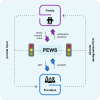Pediatric Early Warning Systems (PEWS) improve provider-family communication from the provider perspective in pediatric cancer patients experiencing clinical deterioration
- PMID: 36128882
- PMCID: PMC9939098
- DOI: 10.1002/cam4.5210
Pediatric Early Warning Systems (PEWS) improve provider-family communication from the provider perspective in pediatric cancer patients experiencing clinical deterioration
Abstract
Background: Communication between providers and patients' families is an integral part of clinical care. Family concern is a validated component of Pediatric Early Warning Systems (PEWS); however, little is known about the impact of PEWS on provider-family communication.
Methods: Semi-structured interviews were conducted with 83 ward and Pediatric Intensive Care Unit (PICU) providers involved in the care of patients with deterioration at two pediatric oncology hospitals of different resource levels: St. Jude Children's Research Hospital (n = 42) in the United States and Unidad Nacional de Oncología Pediátrica (UNOP, n = 41) in Guatemala. Interviews were conducted in the participants' native language (English or Spanish), transcribed, and translated into English. Transcripts were coded by two researchers and analyzed for thematic content surrounding family communication and concern.
Results: All participants recognized patients' families as a valuable part of the care team, particularly during events requiring escalation of care. Perceived barriers to communication included limited time spent at the bedside, and, at UNOP, language and literacy challenges which occasionally limited providers' ability to assess family concern and involve families in patient care. Despite these barriers, providers perceived PEWS improved communication by facilitating more interaction with families, allowing for relationship-building, anticipatory guidance, and destigmatization of the PICU. PEWS assessments also allowed families to contribute to identification of deterioration.
Conclusions: PEWS improve the quality of communication between providers and families by providing more opportunities for interaction, building relationships, and trust. These findings further support the use of PEWS in the care of children with cancer in hospitals of all resource-levels.
Keywords: cancer management; clinical cancer research; clinical guidelines; medical oncology; pediatric cancer.
© 2022 The Authors. Cancer Medicine published by John Wiley & Sons Ltd.
Conflict of interest statement
The authors have no conflict of interests to disclose.
Figures

References
-
- Henry M, Nichols S, Hwang JM, et al. Barriers to communicating a cancer diagnosis to patients in a low‐ to middle‐income context. J Psychosoc Oncol Res Pract. 2021;3(2):e049. doi:10.1097/OR9.0000000000000049 - DOI
Publication types
MeSH terms
LinkOut - more resources
Full Text Sources
Medical

